Irène Awret
1921–2014
Irène Awret was born to a Jewish family in Berlin called Spicker, the youngest of three children. Her mother died in 1927, when Irène was six years old. In 1937 she was forced to stop high school, due to the Nazi race laws. Because she could not continue her regular studies, her father sent her to study drawing, painting and art restoration with a Jewish painter. Among his students were a large number of German Jews who knew they would have to leave Germany within a short time and would require a profession to enable them to support themselves.
When the situation grew worse, following the Kristallnacht (the first major attack on German and Austrian Jews in November 1938), her uncle decided to move to Belgium. In 1939 the situation became even worse - her father was fired from his job and the family were forced to leave their home. As a result, Awret's father tried to send her and her sister to Belgium, with the help of smugglers. The first smuggler proved to be a double agent and they were sent back from Aachen to Berlin. Two weeks later they made a second, successful, attempt to sneak across the border.
Awret worked for a Dutch Jewish family as a maid. As she had her room and board there, she was able to save enough money to study art part-time at Brussels' Académie Royal des Beaux-Arts. A few months later Awret's father joined her and her financial situation became easier. She left her job and studied full-time, helping support herself with restoration work when it was available and by painting portraits to order.
The beginning of World War II (September 1939) coincided with the beginning of Awret's studies at the art academy, but for a few months her life did not change at all. Only with the German occupation of Belgium in May 1940 did things change for the worse. Awret and her family lived with her uncle and his two sons. These two boys and her brother-in-law were sent to a camp in France because they had German citizenship, but Awret was able to continue her studies and even make new friends.
Later, Awret found a hiding place on a farm in Waterloo with a Jewish family who were connected with the underground. In January 1943 she had to return to Brussels, living with a false identity card which stated she was a married woman with two children. Awret succeeded in renting an attic without informing the police where she was - she told her landlady that she had been forced to flee her husband because he beat her. While there, she supported herself by restoring wooden sculptures.
A Jewish informer gave her up to the Gestapo, accompanying the two Gestapo men who arrested her. Awret was able to take a bag containing food and drawing materials. She was detained in the Gestapo cellars in Brussels where she drew. Because there was nothing there to draw, she sketched her own hand. Awret was interrogated in order to reveal the hiding place of her father who was still in Brussels. The National Socialist regime was determined to persecute him, even though he had fought for Germany in World War I and been permanently disabled. They stepped up their torture and brought Awret before Hartmann, the head of the Gestapo in Brussels. When Hartmann saw her block of drawings, he asked her where she had studied art and halted the interrogation.
Awret was placed in a narrow cell and then transferred to Malines camp, which the Belgian's called Mechelen. Malines was a transit camp to Auschwitz, regularly sending 2000 people at a time. Although she arrived just before Transport No. 20, Irène Awret avoided being included. Instead she was put to work in the leather workshop, decorating broaches. While she was there, Hartmann visited the camp and spotted her: "I could have discovered where your father is hiding," he told her. When her artistic talents became known, she was transferred to the Mahlerstube (artist's workshop) where she worked producing graphics for the Germans until the end of the war.
Awret's job enabled her to paint and draw - mainly in pencil, but also in watercolours and oils. In the artists' workshop she met a Jewish refugee from Poland - Azriel Awret - who would later become her husband. Among the other artists in the workshop were Herbert von Ledermann-Vütemberg, a sculptor from an aristocratic family with Jewish roots, Léon Landau, and Smilowitz, who perished in the camps in the East. Irène and Azriel tried to bribe a German officer to prevent Smilowitz's deportation. Not only were they unsuccessful, but they were almost put onto the same train. Jacques Ochs was another artist with whom they became friends in the camp. Ochs, a French-born Protestant who lived in Belgium, was interned as a political prisoner. He remained in Belgium after liberation.
After the war the Awrets immigrated to Israel and made their home in Safed. They continued to work, setting up a studio in Safed's artists' quarter. Today they divide their time between Israel and the United States.
The Beit Lohamei Haghetaot (Ghetto Fighters' House Museum) art collection holds works donated by Awret. These date from her time in Malines camp and from her stay in Brussels after the war, when she was in the company of orphans who had hidden while their parents were sent to Auschwitz.
(Dr Pnina Rosenberg)
References
Irène Awret's Testimony, Ghetto Fighters' House, no date.
Interview with Dr Pnina Rosenberg, August-September, 2000.
The Museum of Deportation and Resistance, Malin (Mechlen) archive, Belgium.
Janet Blater and Sybil Milton. Art of the Holocaust. Pan Books, London, 1982.
Miriam Novitch, Spiritual Resistance: Art from Concentration Camps 1940-1945 - A selection of drawings and paintings from the collection of Kibbutz Lohamei Haghetaot. Union of American Hebrew Congregations, 1981.


On the reverse is a caricature of a man smoking by Jacques Ochs
© Beit Lohamei Haghetaot
Museum Number 123.
Donated by the artist

On the reverse are further sketches done when the artist was transferred to Malines Camp.
Inscribed (in French), lower right: La cave de la Gestapo, Av. Louise, Bruxelles, 1943 [The Gestapo cave, Av. Louise, Brussels, 1943]
© Beit Lohamei Haghetaot
Museum Number 122.
Donated by the artist, Irène Awret
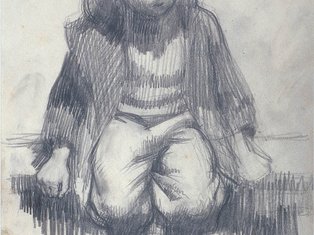
Inscribed (in French) on reverse, lower left: Petite fille déportée [little girl deportee]
© Beit Lohamei Haghetaot
Museum Number 110.
Donated by the artist, Irène Awret
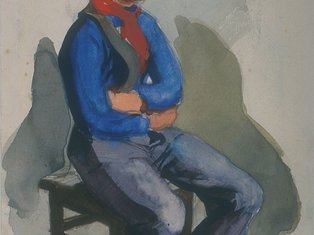
© Beit Lohamei Haghetaot
Museum Number 116.
Donated by the artist, Irène Awret

Picture depicts Jewish orphans in Brussels shortly after the liberation. They had survived the war in hiding, their parents having been deported to Auschwitz, via Malines Camp.
© Beit Lohamei Haghetaot
Museum Number 102.
Donated by the artist, Irène Awret

© Beit Lohamei Haghetaot
Museum Number 124.
Donated by the artist, Irène Awret
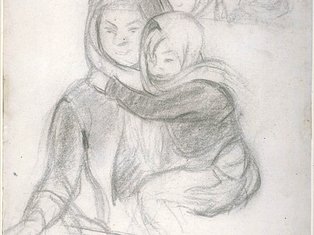
© Beit Lohamei Haghetaot
Museum Number 117.
Donated by the artist, Irène Awret
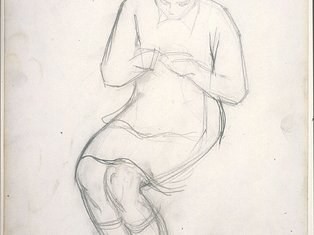
The sitter was identified by the artist
© Beit Lohamei Haghetaot
Museum Number 120.
Donated by the artist, Irène Awret
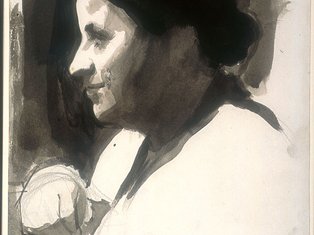
© Beit Lohamei Haghetaot
Museum Number 115.
Donated by the artist, Irène Awret

The sitter was identified by the artist
© Beit Lohamei Haghetaot
Museum Number 113.
Donated by the artist, Irène Awret

The sitter was identified by the artist
© Beit Lohamei Haghetaot
Museum Number 127.
Donated by the artist, Irène Awret
